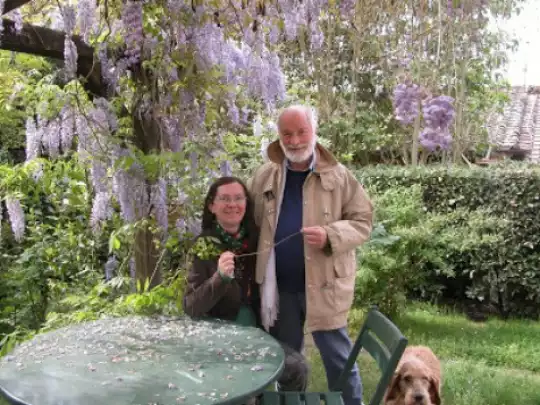
Dear lay friends, I would like to speak again on lay spirituality. Below is a text that can be sent - if you agree - to promote free spiritual expression in a secular and syncretistic way. I would really appreciate if any of you were willing to translate this writing into any language (French, German, Chinese, Spanish, etc.) and then spread around it in that language and in all possible ways. Your help will be welcome because there is still a lot of distortion and misunderstanding by the various religions, about the true meaning of "lay" and "spirit" and it is really important to clarify it...
Thank you for your collaboration ... Cheerfully yours, Paolo D'Arpini
------
Text: "Lay Spirituality"
I would like to clarify the lexical, etymological and conceptual meaning of "lay spirituality" which is mistakenly used to describe a way of spiritual expression by secular members of any religion... In truth, the term "Lay" comes from the Greek "Laikos" which means not belonging to a religious, philosophical or political creed. "Lay" means "not belonging to any socially structured context", similar to the Sanskrit word "avadhuta", that is "beyond any convention". So it is unthinkable that a believing member of any religion could expresses itself in a "lay" way.
In reality "lay spirituality" is the natural spirituality, the spontaneous search in man for his true state, for the mysterious meaning of life, this craving that leads to know one self and consequently each other. The word closest to the expression of this concept is "self-wonder or awe".
I would like to specify that "spirit" for me means "synthesis of intelligence and consciousness" and I also confirm that I am in no way a "believer", what I say is based on my direct experience of existing and being aware of it.
I don't need anyone to confirm it and this is true - obviously - for everyone. It is not necessary to "believe" in existence to say "I am", we already know this for ourselves without a shadow of a doubt. On the contrary, to claim and presume that we have or not trust, we have to take the term "I believe" or "I don't believe".
From this we can conclude that being and being aware of it is natural and unmistakably true, while if you claim something that is based on your thoughts or on mental speculation, it is only the result of a mental process, a way of conceptualizing.
I don't want to make things difficult, but it is obvious that nobody will ever say: "I believe I exist" while considering any other assumptions (be it an abstract or concrete model of thought) you will always have to use the expressions "I believe in this or that..." in religion or atheism or in any other model we trust...
"I am" is therefore pure and simple truth and it is useless to explain the reason, the origin and the importance of "being" because any interpretation can only be defined in a speculative form and therefore it is an opinion and not a direct experience.
We leave it to the "sophists" to state that consciousness is the result of a divine spark or a natural process of matter that transforms itself into life. "I am" is the only incontrovertible fact that needs no evidence or discussion. There is no point in discussing "ways" ... or "guessing" about the truth of the I am.
I say this to calm any conflict over the reality of the fact that I have just expressed (and everyone can recognize it with a serene mind). This is the nature and meaning of secular spirituality.
"Lay spirituality" is a simple spontaneous recognition of the Being in each one of us ... Being Self-awareness!
Paolo D'Arpini
..............................
Testo Italiano
Cari amici laici, vorrei parlare di nuovo di spiritualità laica. Di seguito trovate un testo che può essere trasmesso - se siete d'accordo - per promuovere la libera espressione spirituale in modo laico e sincretistico. Gradirei davvero se qualcuno di voi fosse disposto a tradurre questo scritto in qualsiasi lingua (francese, tedesco, cinese, spagnolo, ecc.) e poi diffonderlo in quella lingua e in tutti i modi possibili. Il vostro aiuto sarà benvenuto perché c'è ancora molta distorsione e incomprensione da parte delle varie religioni sul vero significato di "laico" e "spirito" ed è davvero importante chiarirlo ...
Grazie per la collaborazione che vorrete dare ...
Allegramente vostro, Paolo D’Arpini
------
Testo: "Spiritualità laica"
Vorrei chiarire il significato lessicale, etimologico e concettuale di "spiritualità laica" che viene erroneamente usato per descrivere un modo di espressione spirituale da parte dei membri laici di qualsiasi religione ... In verità, il termine "laico" deriva dal greco "Laikos" che significa non appartenente a un credo religioso, filosofico o politico. "Lay" significa "non appartenente ad alcun contesto socialmente strutturato", simile alla parola in sanscrito "avadhuta", ovvero "aldilà di ogni convenzione". Quindi è impensabile che un membro credente di qualsiasi religione si esprima in modo "laico".
In realtà la "spiritualità laica" è la spiritualità naturale, la ricerca spontanea dell'uomo per la sua origine, per il significato misterioso della vita, questa brama che porta a conoscersi. La parola che più si avvicina all'espressione di questo concetto è "meraviglia di Sé".
Vorrei precisare che "spirito" per me significa "sintesi di intelligenza e coscienza" e confermo anche che non sono in alcun modo un "credente", ciò che dico si basa sulla mia esperienza diretta di esistere e di esserne cosciente.
Non ho bisogno di nessuno che me lo confermi e questo è vero - ovviamente - per tutti. Non è necessario "credere" nell'esistenza per dire "io sono", lo sappiamo già da noi stessi senza ombra di dubbio. Al contrario per rivendicare e presumere di avere o meno fiducia in una religione , dobbiamo assumere il termine "credo" o "non credo".
Da ciò possiamo concludere che essere ed esserne coscienti è naturale e inconfondibilmente vero, mentre se si rivendica qualcosa che è fondato sui propri pensieri o sulla speculazione mentale, è solo un processo nella memoria, un modo di concettualizzare.
Non voglio rendere le cose difficili, ma è ovvio che nessuno dirà mai: "Credo di esistere" mentre considerando qualsiasi altra assunzione (sia un modello di pensiero astratto o concreto) si dovrà sempre usare le espressioni "credo in questo o in quello..." nella religione o nell'ateismo o in qualsiasi altro modello in cui abbiamo fiducia...
"Io sono" è quindi pura e semplice verità ed è inutile spiegare la ragione, l'origine e l'importanza di "essere" perché qualsiasi interpretazione può essere definita solo in forma speculativa e quindi è una opinione e non una esperienza diretta.
Lasciamo ai "sofisti" affermare che la coscienza è il risultato di una scintilla divina o di un processo naturale della materia che si trasforma in vita. "Io sono" è l'unico fatto incontrovertibile che non ha bisogno di prove o discussioni. Non ha senso discutere di "modi" ... o fare "ipotesi" sulla verità dell'Io sono. Lo dico per calmare qualsiasi conflitto sulla realtà del fatto che ho appena espresso (e tutti possono riconoscerlo con una mente serena). Questa è la natura ed il senso della spiritualità laica.
La "spiritualità laica" è un semplice riconoscimento spontaneo dell'Essere in ognuno di noi ... Essere consapevoli di Sé!
Paolo D'Arpini













